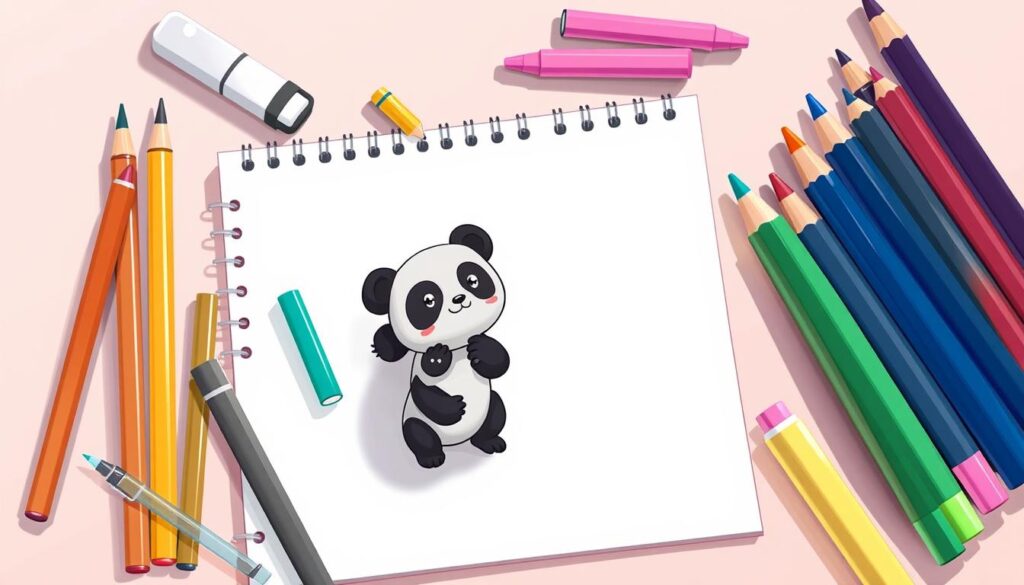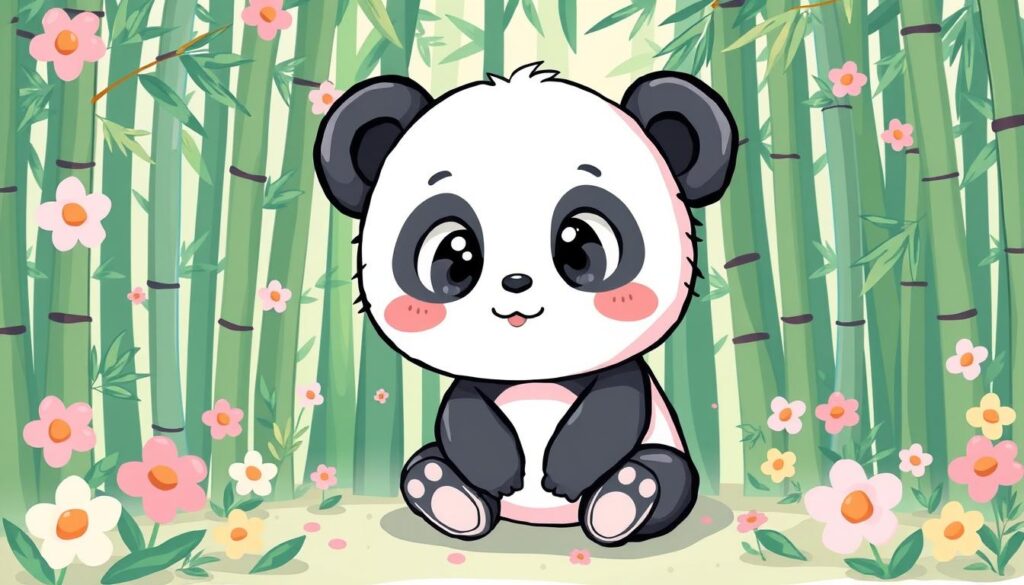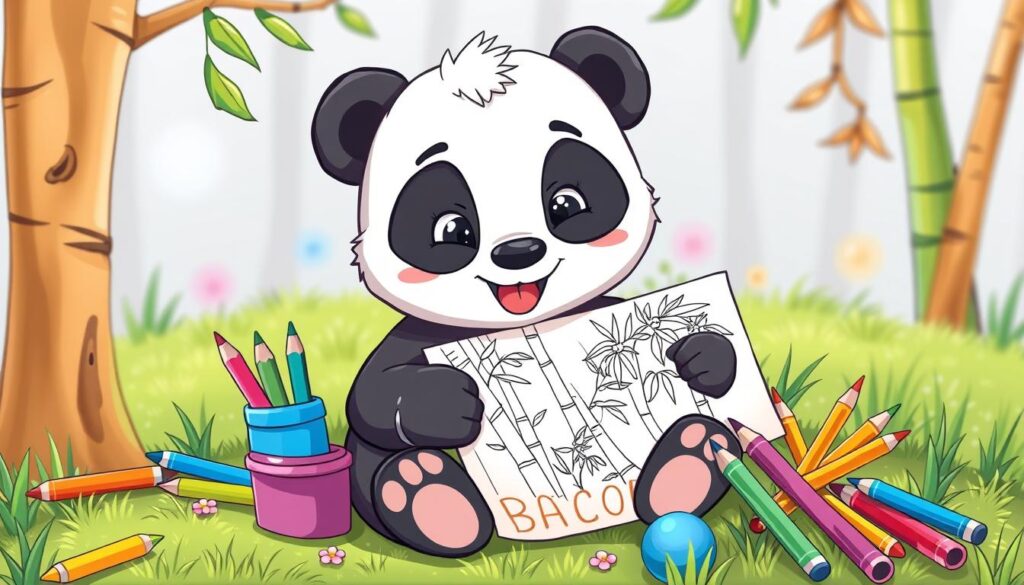I’ve always been inspired by pandas’ charming black-and-white fur. These gentle giants have won hearts worldwide with their sweet nature and love for bamboo. In this guide, I’ll teach you to draw your own panda, great for beginners, kids, and anyone wanting to try art.
This easy cute panda drawing tutorial is for everyone, whether you’re new to drawing or experienced. You’ll learn to create a simple panda illustration that shows the true spirit of pandas.
So, get your pencils and sketchpad ready. Let’s start our panda sketch tutorial. You’ll create a cartoon panda art piece you’ll be proud of.
Sketching Tools for Adorable Panda Artwork

Starting your adorable panda drawings needs the right tools. An H pencil is great for the first outline. It’s light, so you can erase and improve easily. Then, switch to an HB pencil for fine details and shading. A B pencil adds deeper, richer colors.
A kneaded eraser is key for perfecting your panda art. It lets you make changes and highlight parts easily. Use a lightly textured sketch paper for your canvas. It makes your pencil move smoothly, making sketching fun.
| Sketching Tool | Purpose |
|---|---|
| H Pencil | Ideal for outlining and initial sketching |
| HB Pencil | Perfect for adding details and shading |
| B Pencil | Creates deeper, richer tones |
| Kneaded Eraser | Versatile tool for making changes and highlighting areas |
| Textured Sketch Paper | Allows for smooth pencil glide and beautiful artwork |
With these tools, you’re ready to make adorable panda drawings. Let your creativity shine and imagine freely!
Mastering the Basics: Panda Body with Simple Shapes
Starting a step-by-step panda drawing is easy with basic shapes. First, draw a circle for the head and a bigger circle for the body. Then, add two small circles for the ears. Use curved lines to connect the head to the body smoothly.
For the legs, draw kidney bean shapes. The tail is a small oval. Breaking down the panda into these shapes makes it easy to build its body. This is the first step to drawing a cute panda.
Using basic shapes to draw the panda’s body structure is a great method. It makes drawing easier and keeps proportions right. This is key for a step-by-step panda drawing that looks good.
Adding Panda Features with Cute Details

First, outline the panda’s body. Then, add its facial features and fur details. Start with the muzzle, a rounded shape. Next, add black patches around the eyes.
Draw small circles for the irises. Don’t forget the nostrils and mouth. These details make the panda’s face expressive.
To make the panda look fluffy, add short lines along the body. These lines suggest the fur texture. Add claws on the paws and a “V” shape on the belly for the classic panda look.
Creating an adorable panda face is all about the details. Focus on the panda’s eye and nose shape, and the unique fur patterns. With practice, you’ll become a pro at drawing pandas!
Shading Techniques for Lifelike Panda Illustrations

To make your panda drawing come alive, use careful shading. Begin with an HB pencil to darken the ears, eyes, nose, and face. This step highlights the panda’s unique features and adds depth.
Then, switch to a B pencil for deeper shadows on the body, legs, and paws. Make sure to keep the belly and white areas untouched. This keeps the panda’s signature look intact.
Blend the shading with a kneaded eraser for a soft, fluffy look. Erase any lines you don’t want, leaving a detailed, three-dimensional panda. These shading methods for panda drawing and adding depth to panda art are key to creating panda coloring techniques that make your panda pop.
The panda’s unique markings and colors make it a compelling subject. By mastering these shading techniques, you can turn a simple sketch into a realistic masterpiece.
easy cute panda drawing

Creating a cute panda drawing is fun, even if you’re new to drawing. Start with simple shapes and add details to make a lovely panda picture. It’s important to draw step by step, lightly at first and then refine your lines.
To start, use an HB lead mechanical pencil to draw the panda’s body shape, which is like a trapezoid. Then, focus on the face, using a 6B pencil for the eyes. A 4B pencil is great for shading the nose, leaving some highlights for depth.
Blend the fur with your fingers to show off your creativity. Make sure to darken the panda’s eyes for a more personal touch. Finish by signing your name or username, a common way to show you made it.
With patience and the right techniques, you can make this cute panda come to life. Try your hand at a simple panda drawing for beginners, a quick panda sketch tutorial, and an adorable panda art project. Enjoy the journey and let your creativity sparkle in this fun project.
Kawaii Panda Doodles and Cartoon Styles

Looking to add a playful touch to your panda drawings? Exploring kawaii and cartoon styles is a great choice. These styles highlight the panda’s cutest features, like big eyes and fluffy fur.
To draw a kawaii panda, make the head big and the body round. This makes the panda look cute and friendly. Cartoon pandas have simple shapes and bold features, making them fun and eye-catching.
Try different drawing techniques to make your panda pop. Use thick lines for a handmade look and bright colors for fun. Add details like blushing cheeks or fun accessories to show off your panda’s personality.
Creating a kawaii or cartoon panda will make a drawing that grabs attention and makes people smile. Enjoy the fun and creative process of drawing these adorable pandas.
Panda Sketch Tutorial for Beginners of All Ages
Start your artistic journey with this simple panda sketch tutorial. It’s great for kids and adults who are new to drawing. Follow this guide to make cute panda designs quickly.
We begin with the panda’s outline, using basic shapes. It’s important to get the proportions right. We measured the head with a ruler for accuracy. The eyes are four eye widths apart, giving our panda a friendly look.
Then, we add the panda’s face features. We used a 6B pencil for the dark eyes, creating deep tones. The nose was shaded with a 4B pencil, adding depth.
To make the panda look alive, we used a mechanical pencil with HB lead for the fur. We blended the strokes for a soft, fluffy look. An eraser was used to tidy up the fur, making the details stand out.
This easy panda drawing for kids, simple panda art project, and step-by-step panda guide for beginners makes drawing a panda fun. It helps artists of all levels create their own panda art. So, pick up your pencils and start drawing!
Unleashing Creativity with Panda Drawing Prompts

Once you’ve learned to draw a panda, it’s time to get creative. Try drawing your panda in different poses, like sitting or standing. You can even add fun accessories like hats or scarves.
Imagine your panda in different places, like a cozy bedroom or a busy city. Drawing your panda in various settings can be very rewarding. It lets you show off your unique style.
Sharing your panda drawings online or with friends is a great idea. You might get new ideas or feedback that inspires you. Using the panda as a subject can open up a world of creativity and self-expression.
Remember, the most important thing is to have fun while drawing pandas. Let your imagination run wild. Grab your pencils and start drawing your favorite panda. Let the fun begin!
Mastering Panda Proportions and Anatomy
To draw a panda that looks real, knowing its body proportions and anatomy is key. Pandas have a big head and short, strong legs. Their face, with small ears and wide eyes, is unique.
It’s also important to study the panda’s legs, paws, and tail. This helps show how they move naturally. With so many muscles in the human body, drawing a panda might seem hard. But, breaking it down into simple shapes helps artists get it right.
Wannarit Karin, an art teacher with over 10 years of experience, stresses the value of anatomy in art. He says famous artists like Da Vinci studied anatomy to improve their work. Following their example, artists can create detailed and lifelike panda drawings.
Bringing Panda Drawings to Life with Color

Creating a panda on paper is just the start. To really make it come alive, you need to learn how to color. The classic black-and-white look is always popular, but feel free to try different colors. This adds depth, dimension, and personality to your drawing.
Begin by looking at the panda color palette. While black and white is striking, adding gray shades can make it more realistic. Use soft charcoal for the fur and crisp white for highlights to make it stand out.
To add a fun touch, try splashes of color in your panda drawing. Blues, greens, or orange can give it a playful feel. Remember to match the color with the shading and shadows you’ve already done. This will make your panda jump off the page.
Whether you like black and white or colorful, the right coloring techniques for panda art matter. So, pick up your crayons, colored pencils, or digital tools. Let your imagination run wild as you choose the perfect colors for your panda.
Exploring Different Panda Drawing Styles
As an artist, I love to try new things with my panda drawings. I’ve enjoyed making minimalist, line-art pandas using only black and white. This style gives a bold, modern look to my art.
I’ve also tried abstract, expressionistic panda illustrations. By making the panda’s features bigger and more exaggerated, I show emotion and movement. This style lets me be really creative and make unique panda art.
For something fun, I’ve drawn pandas in a kawaii or cartoon style. These pandas are cute and have big eyes and soft bodies. I’ve even added things like bamboo leaves and textured paint splatters to make my art more interesting.
